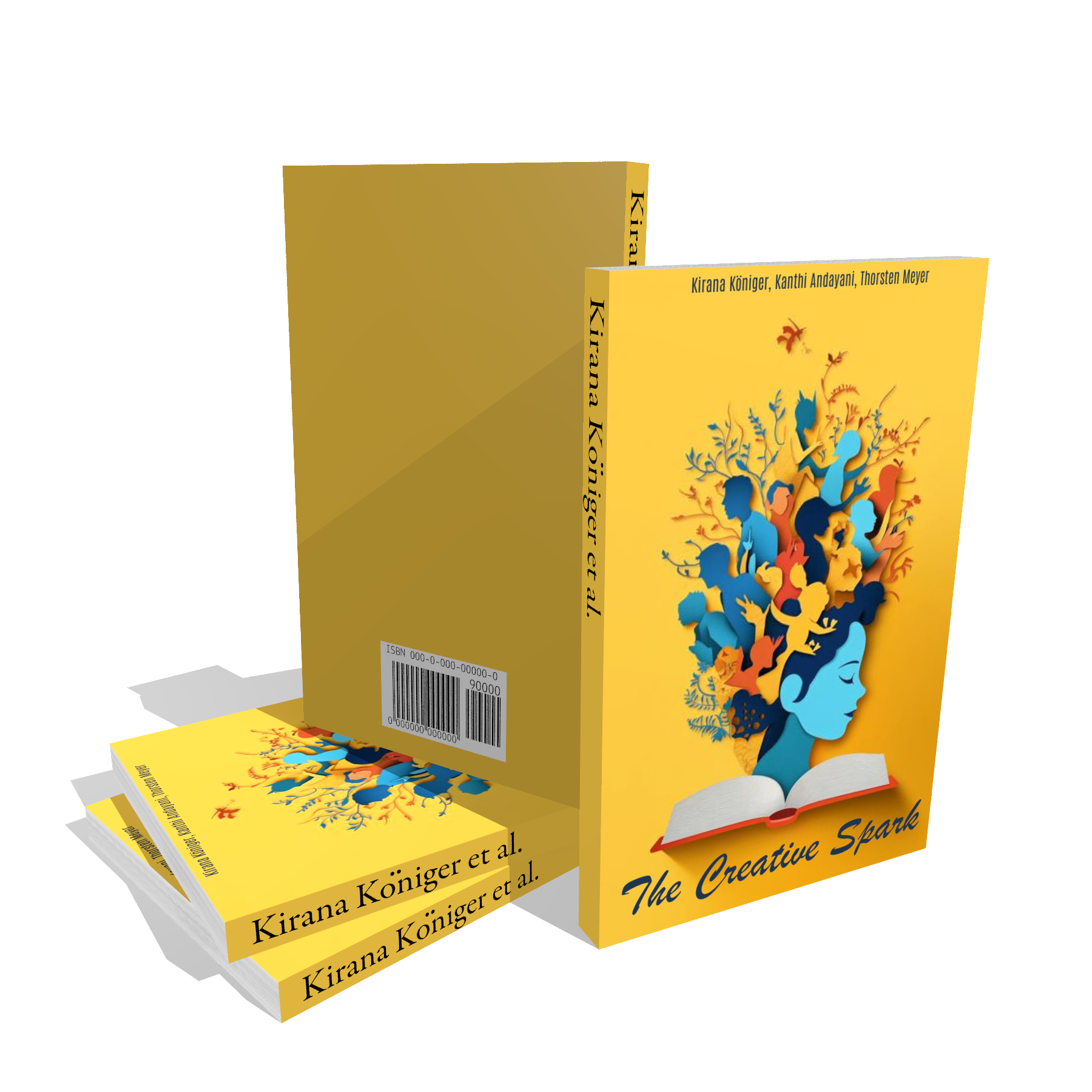Did you know about sonoluminescence? It’s a light showing first seen in 1934. It can heat tiny gas bubbles to 10,000 degrees Fahrenheit. This shows how amazing this sound-driven reaction is. Microscopic bubbles in liquid shine briefly when hit by loud sound waves. This mystery takes you through its history, how it works, and what it means for quantum mechanics and new energy ideas.
There are cool differences between Single Bubble Sonoluminescence (SBSL) and Multi Bubble Sonoluminescence (MBSL). Also, different tests change how bright the light is. Sonoluminescence is where physics meets technology in an exciting way. It makes us rethink how we understand sound waves and opens doors to new discoveries.
Key Takeaways
- Sonoluminescence can achieve temperatures of up to 10,000 degrees Fahrenheit.
- The phenomenon occurs when gas bubbles in a liquid expose to controlled acoustic waves.
- There are two principal theories in sonoluminescence: SBSL and MBSL.
- Research indicates the energy density required can be as low as 10-11 electron volts per molecule.
- The light emitted lasts just a few tens of trillionths of a second.
- Understanding sonoluminescence can have significant implications for future energy sources.
What is Sonoluminescence?
Sonoluminescence is a cool process where tiny gas bubbles in a liquid glow when hit by loud sounds. These bubbles quickly grow and shrink because of sound waves. The light they make lasts for a very short time but is super powerful.
These bubbles can glow brighter than the sun when they pop from the sound. This glow can be even brighter than light from some glowing sea creatures. Yet, we still have a lot to learn about how and why this happens.
We’re still digging into the secrets of sonoluminescence. Scientists want to know how the bubbles make light and keep their shape. They study how sound and light play together, making this topic really fascinating for more research.
| Aspect | Detail |
|---|---|
| Duration of Light Flashes | Approximately 100 picoseconds |
| Temperature of Collapsing Bubbles | Up to 10 times hotter than the sun’s surface |
| Light Emission Intensity | Exceeds that of some bioluminescent organisms |
| Mysteries Uncovered | Light emission mechanism, bubble stability, and acoustic pressure effects |
Exploring sonoluminescence opens up a world where light comes from sound. It shows the cool ways different parts of science come together. As we learn more, each bubble gives us more clues into this mysterious glow.
Historical Background of Sonoluminescence
The history of sonoluminescence began in 1934 by H. Frenzel and H. Schultes at the University of Cologne. They found that bubbles can emit light during cavitation. Their work marked the first step into studying this incredible event.
Over the years, scientists have used different experiments to study how light is produced by bubbles. In 1989, a big leap happened when Felipe Gaitan of the University of Mississippi created sonoluminescence with a single bubble. His experiment showed that bubbles can flash light that lasts about 100 picoseconds during each sound cycle.
Adding noble gases to bubbles changed the light’s intensity and color. However, why this happens is still not fully understood. Researchers discovered this light is mainly ultraviolet with very high bubble temperatures. If the bubble shrinks to just 0.1 microns, the temperature could shoot up to 100,000 Kelvin.
Further studies on sonoluminescence used advanced tools, like photomultiplier tubes, to observe the quick light bursts. This phenomenon involves single and multiple bubbles. It continues to attract interest across many scientific areas.
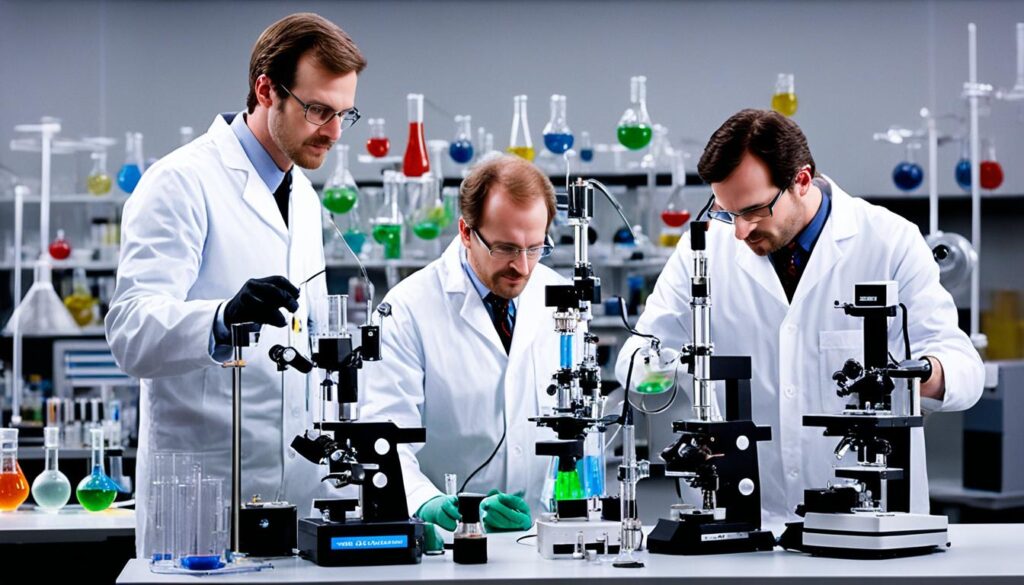
| Year | Discovery/Research | Key Findings |
|---|---|---|
| 1934 | H. Frenzel and H. Schultes | First observation of sonoluminescence |
| 1989 | Felipe Gaitan | First successful single bubble sonoluminescence experiment |
| 1960 | Peter Jarman | Theory proposed: thermal origin from microshocks |
| 1990s | Ongoing studies | Investigation of bubble temperatures and light spectra |
The Science Behind Sonoluminescence
Sonoluminescence is a complex phenomenon that we can understand by looking at some basic physical principles. It mainly focuses on how bubbles behave and how acoustic waves can be manipulated. When certain conditions are met, these bubbles light up briefly.
Understanding Bubble Dynamics
Bubble dynamics are key to sonoluminescence. They show us how bubbles move in liquids. When sound waves hit the bubbles, they compress and expand quickly. This action can create very hot spots inside the bubble.
These hot spots are tiny, but they get so hot that they can shine brightly for a moment. This happens when everything lines up perfectly.
Role of Acoustics in Light Emission
Acoustic waves play a big role in this science. They make the bubbles shine by moving at certain frequencies. One example is a sound wave at 40,000 cycles per second. It can make the bubbles flash light rapidly, about 40,000 times a second.
This shows a special way to make sound energy very concentrated. It creates the perfect setup for these amazing light flashes to happen.
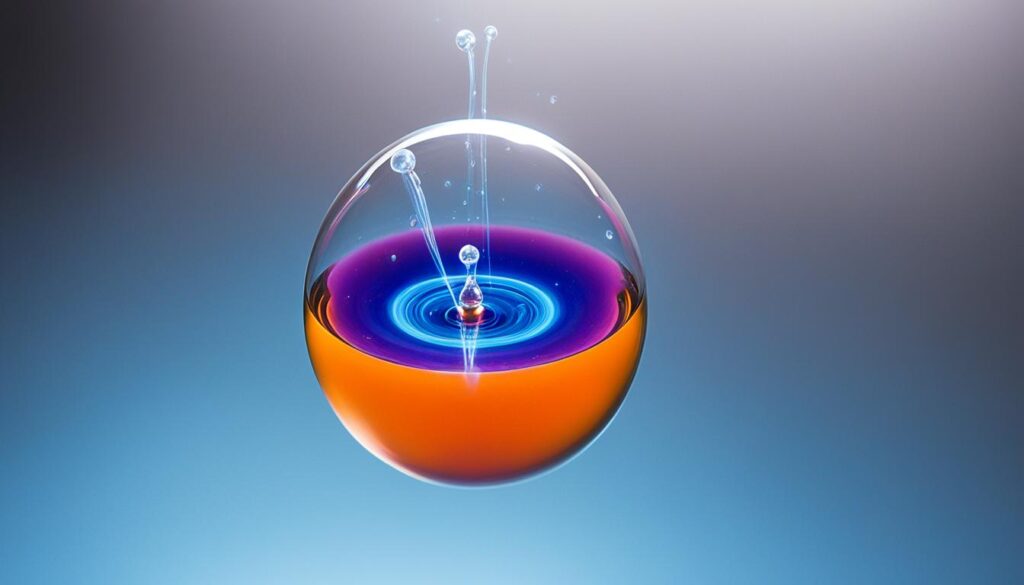
| Factor | Description |
|---|---|
| Energy Concentration | Achieves 12 orders of magnitude concentration of sound wave energy. |
| Hot Spot Size | Ranges from 10 nanometers to 100 microns within bubbles. |
| Flash Intensity | Can release flashes with an intensity of 150 Watts lasting a microsecond. |
| Flash Rate | Generates 40,000 flashes of light per second with acoustic waves. |
| Nuclear Fusion Efficiency | Neutron counting efficiency in an acoustic detector can reach 20%. |
Key Experiments in Sonoluminescence Research
Exploring sonoluminescence has led to many important experiments. This work has made our understanding of this fascinating topic deeper. The journey began with observations by H. Frenzel and H. Schultes in 1934 at the University of Cologne, which opened doors for further sonoluminescence studies.
Scientists create sound waves using ultrasonic transducers in controlled settings. This helps them study bubbles. They’ve found that sonoluminescence can reach temperatures over 10,000 K under the right conditions. This discovery is as surprising as comparing it to the sun. To get accurate measurements of the light, they use tools like photomultiplier tubes.
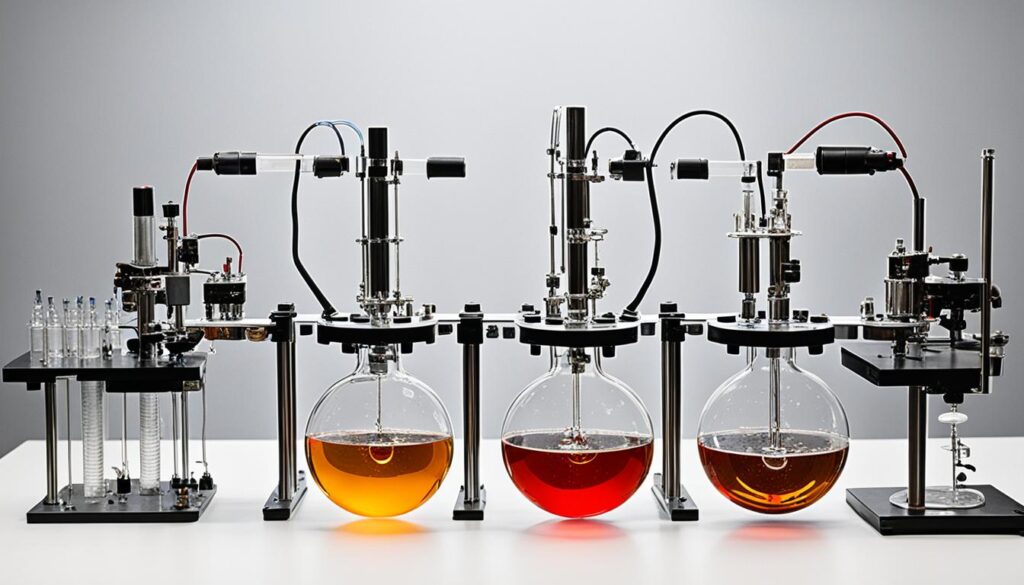
More research, including work by Barber B.P. and Putterman S.J. in the 90s, looked at how different liquids behave. Water, particularly at 0°C, was the best medium for brightness, outshining warmer temperatures. They learned that the light from water is linked to high-energy particles created when bubbles collapse.
- Multi-bubble sonoluminescence (MBSL) shows its brightest light at 310 nm, with a wide range of colors.
- Latest studies have discovered that using ultrasonic waves on volatile organometallic compounds matches emissions with known metals’ atomic lines.
- Research in microgravity shows sonoluminescence gets 20 percent brighter, pushing the field forward.
Our understanding of sonoluminescence is always growing thanks to new experiments. Measurements show cavitation temperatures around 4,900 K, setting important standards. This knowledge helps in energy and material science fields.
| Year | Experiment | Key Findings |
|---|---|---|
| 1934 | Frenzel and Schultes | First observation of sonoluminescence |
| 1991 | Barber and Putterman | Insights into bubble dynamics |
| 2018 | Suslick et al. | Review of bubble chemical history |
| 2020 | Sharipov et al. | Observed formation of hydrated electrons |
| 2021 | Song et al. | Carbon nano-dots influence on sonoluminescence |
The experiments highlight the ongoing progress in sonoluminescence research. They show us the exciting possibilities in this vibrant area of physics. As we discover more, we see how curiosity and importance blend in this fascinating subject.
Sonoluminescence and Quantum Mechanics
The interaction between sonoluminescence and quantum mechanics is fascinating. It shows us how tiny happenings can surprise and enlighten scientists. The essence of sonoluminescence is the quick collapse of gas bubbles in a liquid, causing a burst of light. This event is closely linked with quantum mechanics ideas, indicating that quantum impacts might play a role in the light-show of these dynamic bubbles.
Quantum Effects in Bubbles
Under intense energy and pressure, sonoluminescence demonstrates quantum effects. Bubbles vibrating at about 25 kHz create a stable environment. Here, light flashes briefly, with each pulse lasting only picoseconds. This quick flashing shows how sound energy turns into light, revealing basics of quantum mechanics.
Various theories try to explain sonoluminescence’s light-show, including black-body radiation and bremsstrahlung. However, the study of quantum vacuum radiation has gained attention. It looks at how the Casimir effect can explain the interaction between sound and light. The Unruh effect adds to this by suggesting radiation from shifting dielectrics, which we might see in sonoluminescence.
The impact of these quantum effects is vast. They offer clues into particles’ core actions. They also prompt us to explore further how sound and quantum mechanics are intertwined. The journey from sound waves to light broadens our understanding of energy processes at the microscopic scale.

| Aspect | Details |
|---|---|
| Emission Mechanism | Rapid bubble collapse leading to photon emission. |
| Frequency | Typically around 25 kHz for stable sonoluminescence. |
| Pulse Length | Less than 10 ps (picoseconds). |
| Temperature Inside Bubble | Can reach up to 12,000 K (11,700 °C; 21,100 °F). |
| Light Duration | Lasts between 35 to several hundred picoseconds. |
| Peak Intensity | 1–10 megawatts per flash. |
| Bubble Diameter | About 1 micrometer (3.9×10−5 in). |
| Core Temperatures | Can reach at least 20,000 K (19,700 °C; 35,500 °F). |
Applications of Sonoluminescence in Modern Science
Sonoluminescence is fascinating with many applications in science. It happens when a bubble in a liquid collapses from sound waves, creating light. It is used in material science, medicine, and energy research.
It offers a chance to improve ultrasound imaging. Researchers are learning from sonoluminescence to make imaging clearer and more accurate. This is important for both diagnosing diseases and treating them.
In energy studies, sonoluminescence bubbles reach very high temperatures, similar to the sun. This lets scientists study processes that need extreme heat. It could help us learn more about how energy is made in stars.
Also, sonoluminescence might help in quantum tech advances. The unusual light patterns from it suggest it could be used in quantum computing. Researchers see it as a way to make sources of light that are important for quantum tech.
Here’s a summary table outlining some of the notable applications of sonoluminescence:
| Field | Potential Applications | Benefits |
|---|---|---|
| Medical Imaging | Enhanced ultrasound techniques | Improved resolution and diagnostic accuracy |
| Energy Research | Study of high-energy processes | Insights into energy generation and stellar phenomena |
| Quantum Technology | Design of quantum computers | Development of new quantum systems and photonic sources |
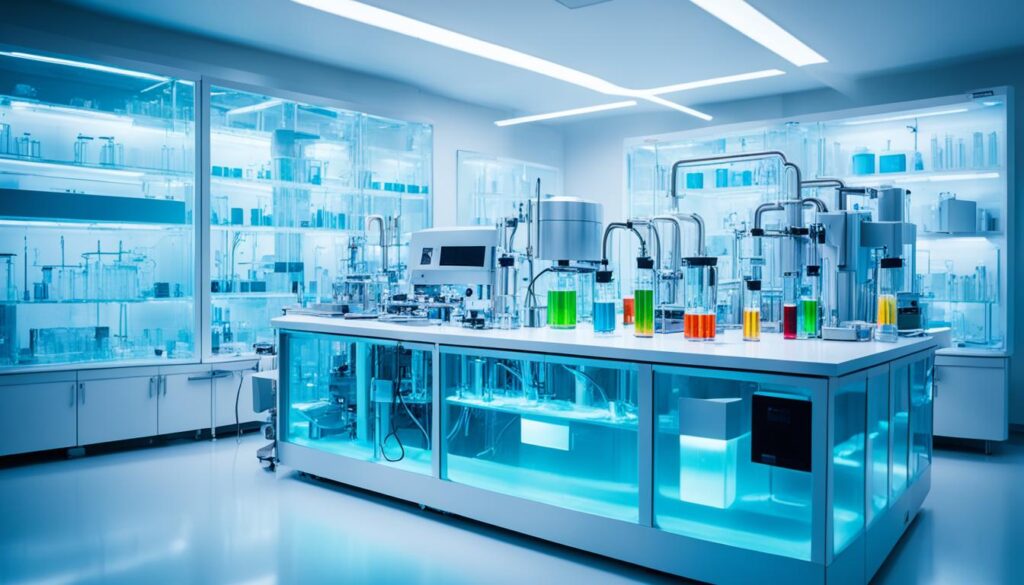
Sonoluminescence and High Temperatures
Sonoluminescence shows us something amazing, especially the high temperatures in bubbles. These bubbles can get really hot, between 6000 K and 20,000 K during single-bubble sonoluminescence (SBSL). It’s fascinating to see how these bubbles heat up to such extreme temperatures.
Temperature Measurements Within Bubbles
Temperature is key when studying sonoluminescence. In SBSL, temperatures often hit 10,000 K, but can spike to 50,000 K. This heat is affected by:
- Adiabatic heating during rapid bubble compression
- Shockwave effects resulting from bubble collapse
- Interactions between viscosity and surface tension
Scientists have come up with equations to explain these hot bubbles. They use complex math like the Keller–Miksis and Prosperetti’s equations. These reveal the thermal dynamics that cause such heat.
The Mystery of Extreme Conditions
Multibubble sonoluminescence (MBSL) reaches temperatures from 2300 K to 5100 K. This is cooler than SBSL, which shines brighter and gets hotter due to less bubble interaction. The differences show how unique single bubbles are.
Bubbles in SBSL collapse under high pressure, making bright light. This light changes with pressure and temperature, plus other factors like dissolved gases. Learning about this helps in many fields, not just science.
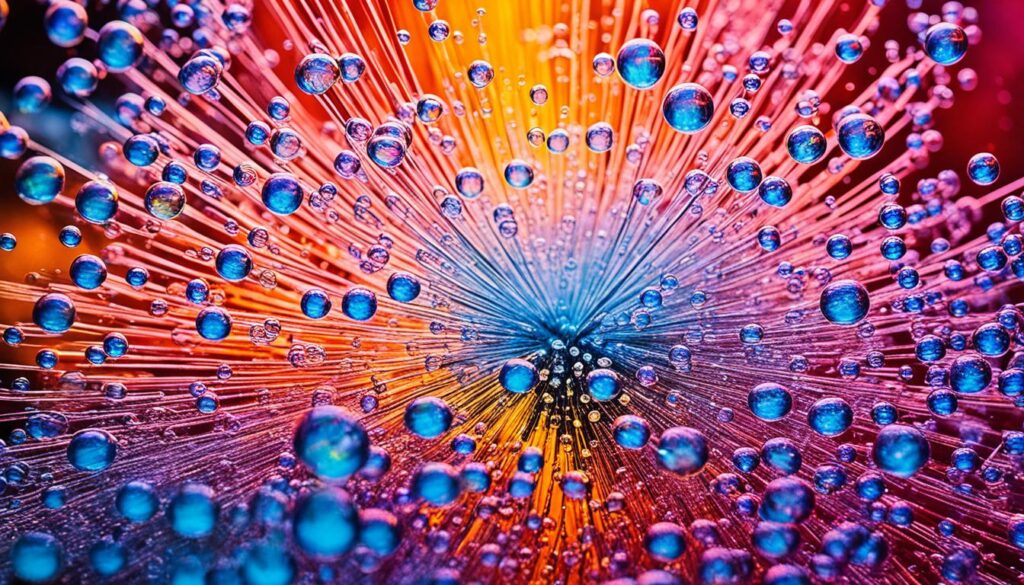
| Type of Sonoluminescence | Temperature Range (K) | Key Features |
|---|---|---|
| Single-Bubble Sonoluminescence (SBSL) | 5000 – 50,000 | Higher light emission, fewer bubble interactions |
| Multi-Bubble Sonoluminescence (MBSL) | 2300 – 5100 | Lower light intensity, more bubble interactions |
Researching sonoluminescence has shown the complex ways bubbles get so hot. These discoveries are important for both science and industry.
The Connection to Higgs Boson and Dark Matter
Scientists are making new discoveries in modern physics. They connect Higgs boson, dark matter, and sonoluminescence in exciting ways. Through sonoluminescence, a light flash from a bursting bubble in liquid, we see potential ties to the Higgs field.
The heat in sonoluminescence bubbles can get really hot, between 6000 K and 20,000 K. This makes us wonder how it all connects to dark matter. By understanding these temperatures, we can learn more about the forces shaping our universe.
Finding the Higgs boson in 2012 was a huge deal. It showed how particles get their mass from the Higgs field. Studying how this field interacts with sonoluminescence might help us understand dark matter better.
Recent research looks into how Terrestrial Gamma-ray Flashes relate to sonoluminescence. Some theories even suggest micro black holes play a role. This could change how we see dark matter and particle physics.

Research on phonons, or units of vibrational energy, is unveiling their importance. They change vibrational energy to electromagnetic energy during sonoluminescence. This might affect how things work within the Higgs field and help us figure out what the universe is made of.
| Phenomenon | Temperature Range (K) | Key Connection |
|---|---|---|
| Sonoluminescence | 6000 – 20000 | Potential insights into dark matter and particle interactions |
| Higgs Boson | N/A | Mass generation for fundamental particles |
| Terrestrial Gamma-ray Flashes | N/A | Possible links to sonoluminescence and dark matter |
How Sonoluminescence Could Revolutionize Energy Sources
Sonoluminescence exploration may change the way we look at energy. Researchers are busy finding ways to use this effect. It happens when tiny bubbles light up under strong sound waves. If these bubbles can start nuclear reactions, we might get endless clean energy.
People are figuring out how sonoluminescence applications could work for energy. Sound waves make a tiny bubble light up for a short time. This happens every 35 microseconds. It’s not just light; heat is made too. This process might even start fusion reactions.
It’s important to understand how these bubbles behave. They respond to sound waves of 25 kHz. Because of this, their internal pressure and size change a lot. These changes make temperatures shoot up. The bubble’s size affects how well we can use this energy.
Below is a table summarizing some significant characteristics of the SBSL process:
| Property | Details |
|---|---|
| Emitted Light Color | Mostly blue and ultraviolet |
| Frequency of Collapses | 35 microseconds between flashes |
| Flash Duration | 50 picoseconds |
| Sound Wave Frequency | 25 kHz |
| Bubble Size Range | Few microns to about 50 microns |
Scientists, like those at Hefei Institutes of Physical Science, are studying new materials. They look at things like carbon nanodots. This research could improve how we control light from sonoluminescence. It might also make energy use more efficient when applying this technology.
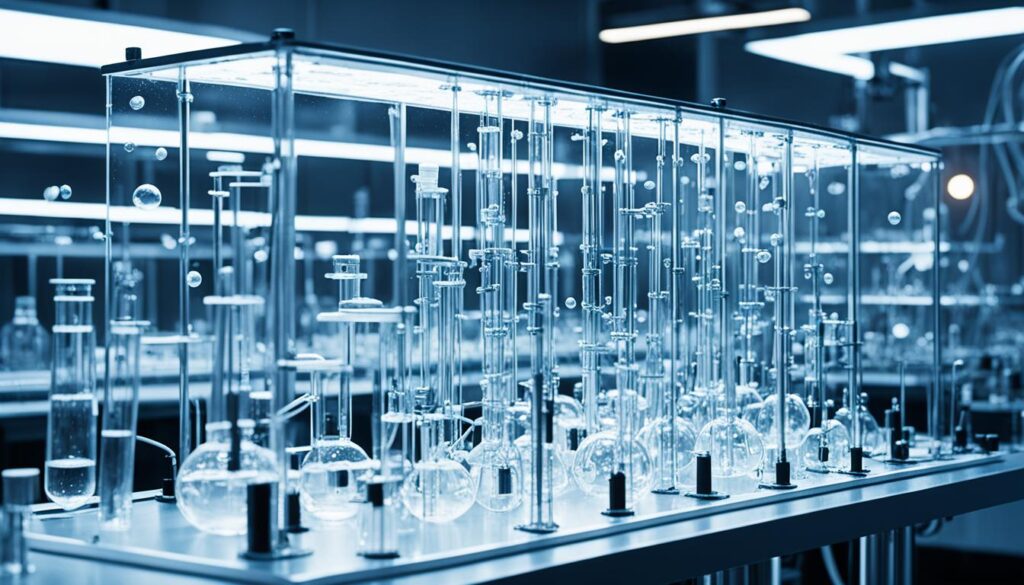
Current Challenges in Studying Sonoluminescence
Studying sonoluminescence is full of challenges in research. This is because the phenomenon happens quickly and is hard to catch. Scientists struggle with scientific hurdles to create the right conditions for this light show. Usually, they work with sounds between 20-40 kHz, which makes experiments tricky.
Using pure and degassed water is a big challenge in these studies. Any impurities can mess with the results by affecting bubble stability. Getting the transducer positioned just right is key. If it’s off even a little, the experiment might not work.
Keeping the room temperature steady is also very important. It can really impact the behavior of the bubbles being studied. If the temperature changes, it can throw off the whole experiment.
Seeing the light from sonoluminescence is another hurdle. It’s usually very faint, so researchers need special techniques like long-exposure photography. This makes the experiments even more complex.

The literature shows that not many studies on sonoluminescence are out there. Between 1933 and 2018, only 52 articles were found. This means the field needs more research. The articles that do exist don’t reference many other studies, with an average of 1.73 references each.
| Publication Statistics | Count |
|---|---|
| Total Articles Analyzed | 52 |
| Average References Per Article | 1.73 |
| Year with Most Articles Published | 2004 |
| Leading Countries in Research | USA (10), Japan (7) |
| Most Cited Authors | Yasui K., Tuziuti T., Iida Y. |
| Average Number of Authors Per Publication | 2.6 |
Understanding these challenges is key to making progress in sonoluminescence studies. By tackling both technical and educational obstacles, researchers can make new discoveries in this interesting area.
Future Directions in Sonoluminescence Research
Research in sonoluminescence is full of potential and opportunity. By getting involved, you can help make big discoveries. These discoveries will teach us more about how it works and its uses. We will not only look into how sonoluminescence happens but also find new technologies to help us along.
A key area to look into is how quantum mechanics affects sonoluminescence. Learning about the quantum side of things could explain how light comes from bubbles. Studying how sound turns into light might open doors for practical uses in energy and making new materials.
Support from experts like Dr. Seth J. Putterman for funding is crucial. Better tools for measuring are needed for progress. For example, newer photomultiplier tubes and fiber-optic spectrometers can give us clearer data. This helps in the scientific research you do.
The impact of different liquids on bubble stability is another important topic. Research from the 1980s has laid a solid groundwork. It showed how temperature and viscosity affect bubble stability. Looking into various solvents might lead to stronger sonoluminescence. This could help in many different areas.
- Focus on quantum mechanics and its effects on sonoluminescence.
- Explore advanced technologies for precision measurements.
- Investigate the impact of liquid compositions on bubble dynamics and stability.
- Enhance understanding of temperature-related material properties.

Taking on these research areas is promising. It could solve complicated scientific puzzles. Plus, it encourages working together, across both universities and companies. By pushing the limits, we’re set for amazing findings. The next steps in studying sonoluminescence are sure to be thrilling and important.
Conclusion
Sonoluminescence intertwines sound and light in a historical and scientific context. Its mechanics raise many questions. But, its significance grows, leading to further inquiry.
Delving into sonoluminescence could revolutionize our understanding of energy. It could change how we generate power and more.
The potential of sonoluminescence extends into many scientific areas. Sustained nuclear fusion through it is a big goal. Yet, challenges like optimal conditions and bubble stability provide a research path.
The future possibilities of sonoluminescence could change our view on energy and matter. They show a new way to look at the world of science.




